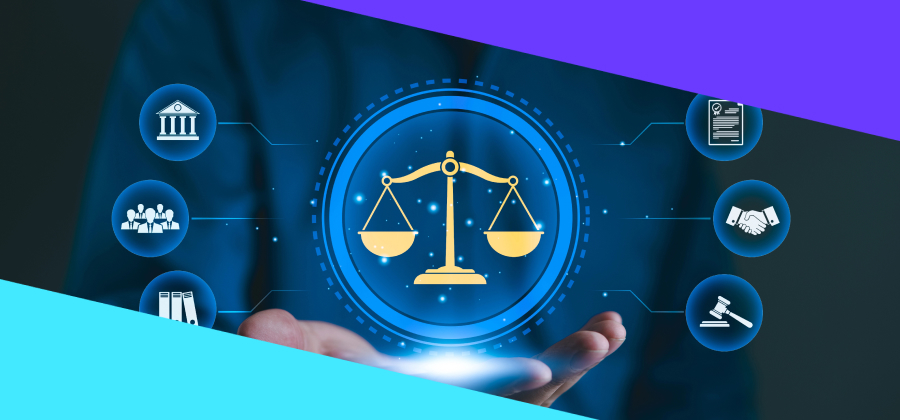Using AI for Evidence Review, Witness Preparation, Cross-Examination Planning and Memo to Counsel drafting
Context
In this Legal Ready AI Use Case, we explore how in-platform AI can support a plaintiff personal injury claim at various phases of the matter – from evidence analysis and witness preparation, to cross-examination preparation and drafting a memo to counsel.
The use case is based on a real damages claim for personal injury (all names changed).
Priscilla Pringle, an elderly shopper, was struck from behind by a line of supermarket trolleys inside a shopping centre, breaking her hip and sustaining psychological injury. Her solicitor, David, uploads 4 key documents to eBrief Ready:
- Priscilla’s initial statement
- Priscilla’s draft affidavit
- Witness statement of Troy Edwards (trolley attendant)
- Witness statement of Amanda Blake (independent bystander)
Here are 5 examples of how @Legal Ready’s in-platform AI dramatically facilitates and sharpens case preparation.
1️⃣ Rapid Evidence Review: Mapping Inconsistencies Across Witness Accounts
David runs eBrief Ready’s Analyse across the documents with the prompt:
Compare the affidavit of Priscilla Pringle with the witness statements of Amanda Blake and Troy Edwards. Identify all inconsistencies, contradictions, or material differences between the three accounts. For each inconsistency, quote or reference the statements and explain why the accounts differ. Provide the output in a clear, structured table.
Within seconds, the AI produces a clear inconsistency matrix mapping contradictions and gaps across the three accounts in an easy to review format:
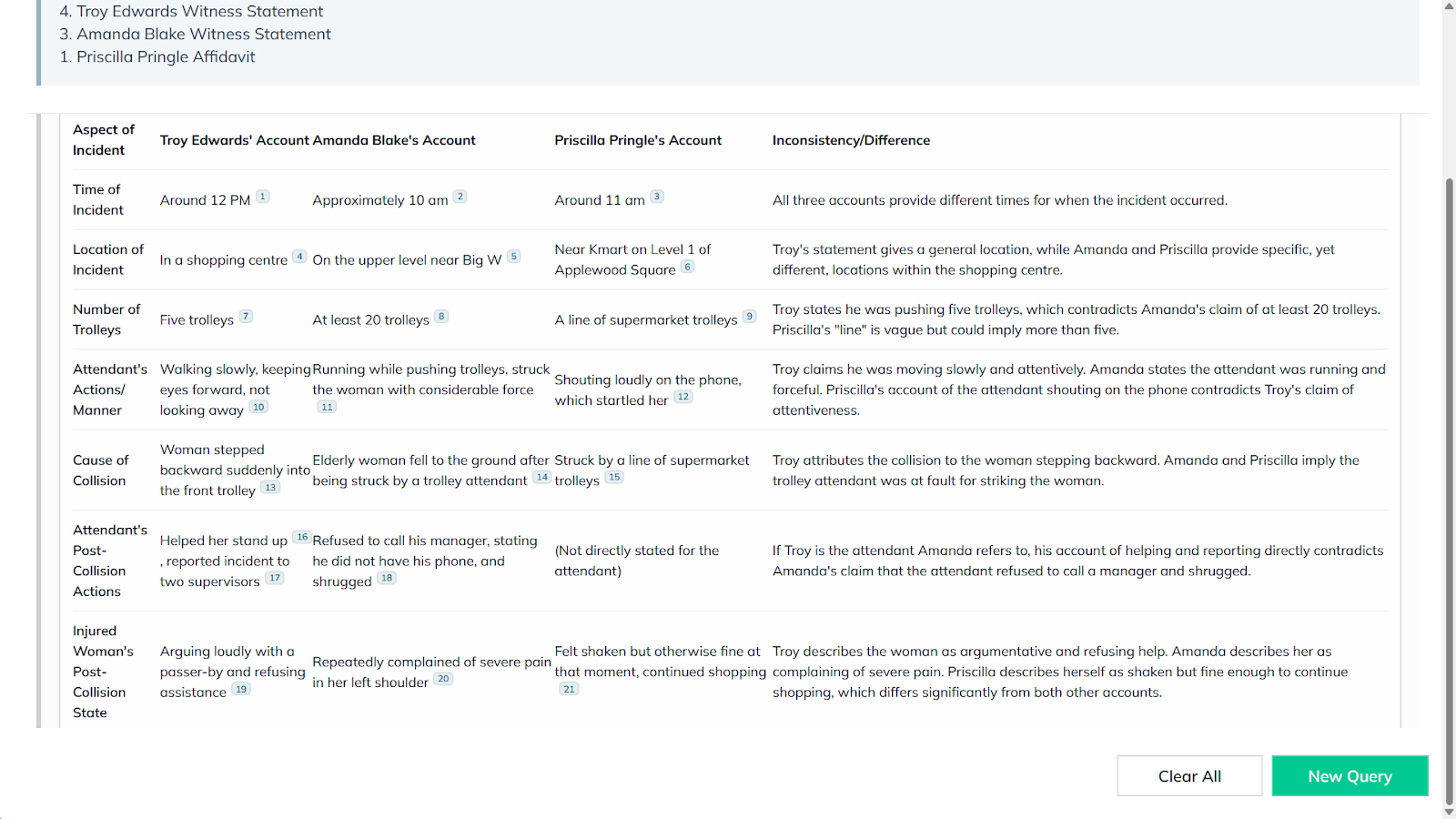
Why it matters: manual comparison might take hours – this takes seconds, providing immediate evidentiary clarity.
2️⃣ Clarifying Client Evidence
David next focuses on clarifying potential inconsistencies in Priscilla’s affidavit by asking:
Draft questions I could ask my client, Priscilla, to clarify potential inconsistencies in her statement

The AI generates a comprehensive checklist of clarification questions. Not all will be needed, but David now has a structured discussion plan for his client conference later that day.
Important Note: Practitioners should always have regard to any court guidelines on the use of AI to generate the content of affidavits, witness statements, character references or other material intended to reflect a deponent’s or witness’s evidence and/or opinion; see for example, Supreme Court of NSW’s Practice Note SC Gen 23, 3 February 2025.
3️⃣ Preparing the Client For Cross-Examination
Closer to trial, David can use eBrief Ready’s Analyse to anticipate potential lines of attack:
What questions might the defendant’s counsel ask my client in cross examination?
The AI produces a realistic list of cross-examination themes and questions, helping David prepare his client for what to expect under pressure.
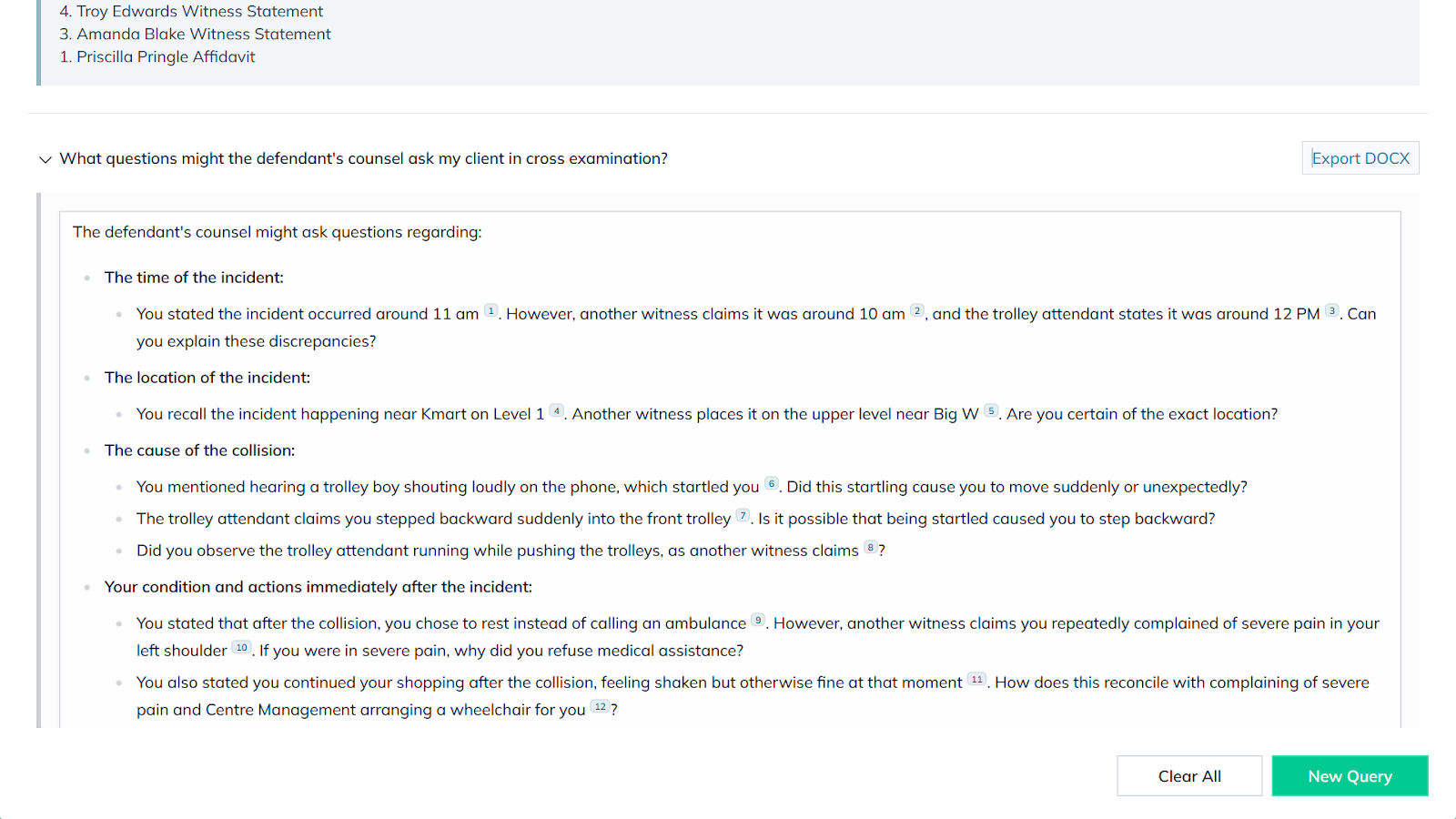
4️⃣ Drafting a Cross-Examination Plan for the Trolley Operator
To prepare for Troy Edwards’ cross-examination, David uses eBrief Ready’s Analyse:
Prepare cross-examination questions for Troy Edwards focused on inconsistencies in his statement and his duty of care.
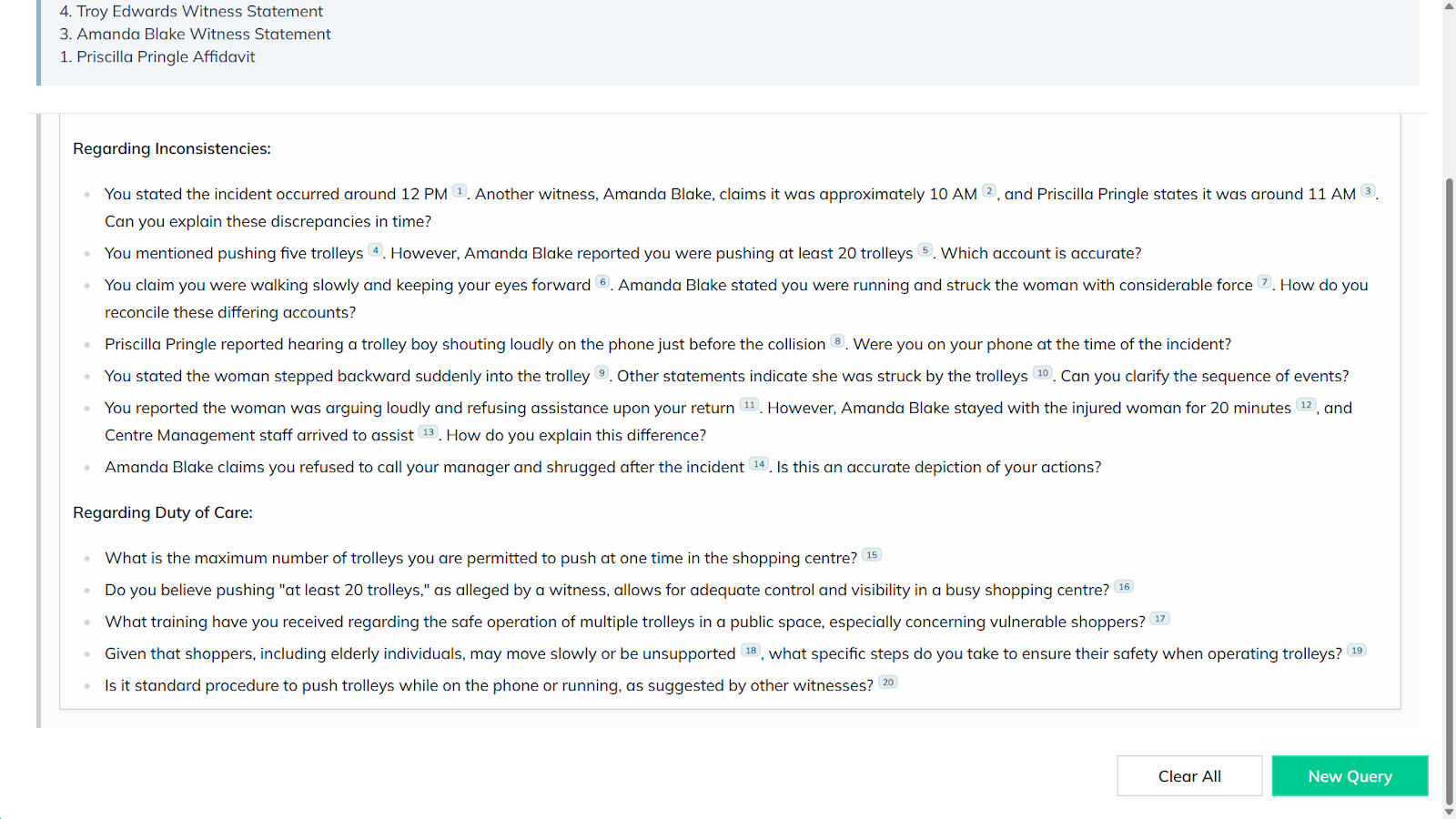
Within minutes, he has a structured cross-examination outline drilling into:
- conflicting versions of events
- omissions in Troy’s account
- potential breaches of duty.
This becomes the foundation for a compelling line of questioning and can be used in combination with eBrief Ready’s annotation function, which enables Troy’s witness statement to be marked up and referenced by the barrister in court.
5️⃣ Drafting a Memo to Counsel
David is now ready to brief counsel on Priscilla’s matter. In addition to sharing the matter and its constituent documents electronically using eBrief Ready, David prepares a first draft of a memo to counsel summarising Priscilla’s claim. He selects relevant documents from the matter and also adds the leading High Court authority on negligence and occupier’s duty: Australian Safeway Stores Pty Ltd v Zaluzna (1987), and prompts:
Prepare a memo to the barrister representing my client summarising her claim, key prospects of success and briefly refer to the applicable principles in Zalzuna.
The AI produces a detailed draft memo covering factual summary; duty and breach; causation, foreseeability; how Zaluzna applies.


Hoping to be extra helpful, David then uses eBrief Ready’s Analyse to prompt:
Give me all the case law applied on this subject after Zalzuna so that I can send it to my barrister in the brief
The AI responds that it cannot search beyond uploaded materials, reflecting the closed-source, no-hallucination architecture deployed in eBrief Ready’s platform. David will need to continue his legal research outside the platform.
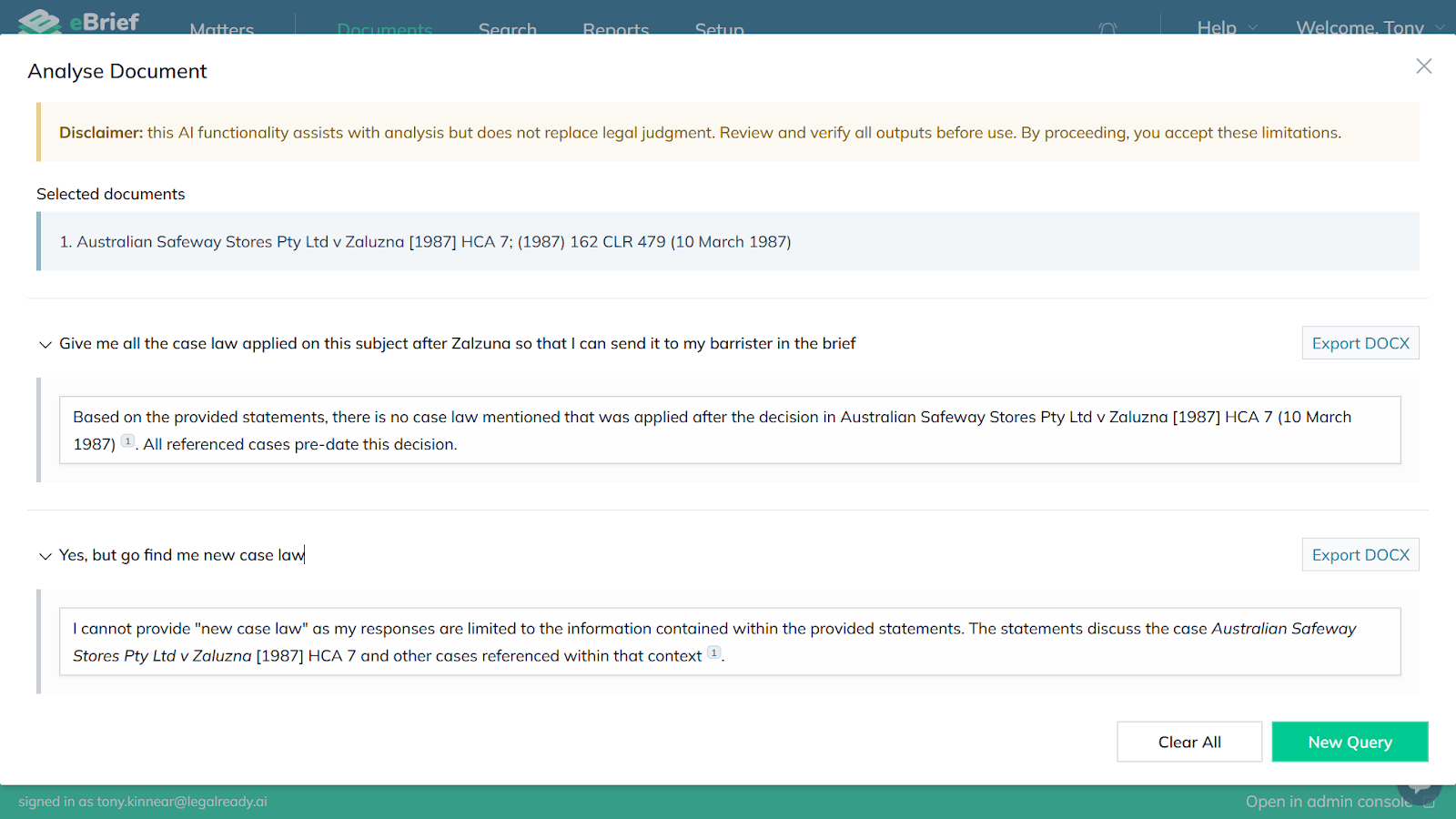
Why This Matters — The Future of Legal Practice
Even in a straightforward personal injury claim, Legal Ready’s AI supports multiple stages of litigation preparation:
- Document comparison
- Fact-conflict analysis
- Client follow-up questions
- Cross-examination planning
- Drafting a memo to counsel
All performed inside a secure, permission-controlled, in-platform environment — without exposing a single document to external AI systems.
This isn’t AI replacing lawyers. This is AI amplifying lawyers — improving preparation, sharpening evidence, reducing time pressure, and supporting faster, safer, more accurate work for clients.
Even in a simple matter, benefits can be significant. This will be compounded in complex cases and high-volume litigation.
If you have comments, examples, challenges or workflows you’d like us to feature in Legal Ready’s AI Use Case Series, connect with us directly. We’re showcasing real ways lawyers are using Legal Ready to deliver safer, faster, more accurate legal work.
